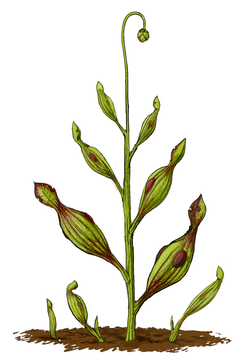| Name | Status | Novelty | Authors | Age | Unit | Location | Notes | Images |
|---|
Afrocygnus chauvireae [42] | Valid | Gen. nov. et Sp. nov. | Antoine Louchart Patrick Vignaud Andossa Likius Hassane Taisso Mackaye Michel Brunet | Late Miocene | Anthracotheriid Unit |  Chad Chad
| An Anatidae, the oldest from Africa. | |
Aquila nipaloides [43] | Valid | Sp. nov. | Antoine Louchart Claudia Bedetti Marco Pavia | Pleistocene | Corsica and Sardinia |  France: France:
 Corsica; Corsica;
 Italy: Italy:
 Sardinia Sardinia
| An Island Accipitridae. | |
Chascacocolius cacicirostris [44] | Valid | Sp. nov. | Gerald Mayr | Early Middle Eocene | Messel pit, MP 11 |  Germany: Germany:
 Hessen Hessen
| A Coliiformes, Chascacocoliidae Zelenkov et Dyke, 2008. | |
Ciconia louisebolesae [45] | Valid | Sp. nov. | Walter E. Boles | Late Oligocene-Early Miocene | Riversleigh |  Australia: Australia:
 Queensland Queensland
| A Ciconiidae. | |
Crossvallia unienwillia [46] | Valid | Gen. nov. et Sp. nov. | Claudia P. Tambussi Marcelo A. Reguero Sergio A. Marenssi Sergio N. Santillana | Late Paleocene | Cross Valley Formation |  Antarctica Antarctica
| A Spheniscidae. | |
Dalianraptor cuhe [47] | Valid | Gen. nov. et Sp. nov. | Gao Chunling Liu Jinyuan | Early Cretaceous, Early Albian | Jiufotang Formation |  China China
| An Ornithurae Haeckel, 1866. This is the type species of the genus. | |
Eurofluvioviridavis robustipes [48] | Valid | Gen. nov. et Sp. nov. | Gerald Mayr | Early Eocene | MP 8; Messel pit, MP 11 |  UK: UK:
 England; England;
 Germany: Germany:
 Hessen Hessen
| A Podargiformes, Fluvioviridavidae Mayr, 2005. | |
Gallinula disneyi [49] | Valid | Sp. nov. | Walter E. Boles | Oligocene-Miocene | Riversleigh |  Australia: Australia:
 Queensland Queensland
| A Rallidae, in 2011 this species becomes the type species of the new genus Australlus Worthy et Boles, 2011. | |
Gallirallus vekamatolu [50] | Valid | Sp. nov. | Jeremy J. Kirchman David W. Steadman | Holocene | ‘Eua |  Tonga Tonga
| A Rallidae. | |
Hongshanornis longicresta [51] | Valid | Gen. nov. et Sp. nov. | Zhou Zhonghe Zhang Fucheng | Early Cretaceous | Yixian Formation |  China China
| An Ornithuromorphae Chiappe, Ji, Ji et Norell, 1999, Hongshanornithidae O’Connor, Gao et Chiappe, 2010. This is the type species of the genus. |
Limnofregata hasegawai [52] | Valid | Sp. nov. | Storrs L. Olson Hiroshige Matsuoka | Late Early Eocene | Green River Formation |  USA ( USA ( Wyoming) Wyoming)
| A Fregatidae, Limnofregatinae Olson, 1977. | |
Lithoptila abdounensis [53] | Valid | Gen. nov. et Sp. nov. | Estelle Bourdon Baâdi Bouya Mohamed Iarochène | Late Paleocene-Early Eocene | Thanetian |  Morocco Morocco
| A Prophaethontidae Harrison et Walker, 1976. | |
Oxyura vantetsi [54] | Valid | Sp. nov. | Trevor H. Worthy | Holocene | Lake Poukawa |  New Zealand New Zealand
| An Anatidae, extinct since the 16th century. | |
Parvigrus pohli [55] | Valid | Gen. nov. et Sp. nov. | Gerald Mayr | Early Oligocene | Pichovet, Vachères, Southern France |  France France
| A Parvigruidae Mayr, 2005. | |
Perugyps diazi [56] | Valid | Gen. nov. et Sp. nov. | Marcelo Stucchi Steven D. Emslie | Late Miocene-Early Pliocene | Pisco Formation |  Peru Peru
| A Cathartidae. | |
Protocypselomorphus manfredkelleri [57] | Valid | Gen. nov. et Sp. nov. | Gerald Mayr | Early Middle Eocene | Messel pit, MP 11 |  Germany: Germany:
 Hessen Hessen
| A Cypselomorphae (Sensu Mayr, 2002). | |
? Primotrogon pumilio [58] | Valid | Sp. nov. | Gerald Mayr | Early Middle Eocene | Messel pit, MP 11 |  Germany: Germany:
 Hessen Hessen
| A Trogonidae, In 2009 Mayr creates the new genus Masillatrogon for this species and makes ?Primotrogon pumilio its type species. | |
Pseudoseisuropsis cuelloi [59] | Valid | Gen. nov. et Sp. nov. | Santiago Claramunt Andrès Rinderknecht | Late Pleistocene | Coastal cliffs near Rio de la Plata estuary |  Uruguay Uruguay
| A Furnariidae. | |
Rallus eivissensis [60] | Valid | Sp. nov. | Miquel McMinn M. Palmer Josep A. Alcover | Pleistocene, Holocene | Ibiza |  Spain: Spain:
 Ibiza Ibiza
| A Rallidae. | |
Rhodacanthis forfex [61] | Valid | Sp. nov. | Helen F. James Storrs L. Olson | Holocene | Kauai |  USA: USA:
 Hawaii Hawaii
| A Fringillidae, Carduelinae, Drepanidini. | |
Rhodacanthis litotes [61] | Valid | Sp. nov. | Helen F. James Storrs L. Olson | Holocene | Oahu |  USA: USA:
 Hawaii Hawaii
| A Fringillidae, Carduelinae, Drepanidini. | |
Rupelramphastoides knopfi [62] | Valid | Gen. nov. et Sp. nov. | Gerald Mayr | Early Oligocene | Rupelian |  Germany: Germany:
 Baden-Württemberg Baden-Württemberg
| A Pici (sensu Simpson and Cracraft, 1981), family incertae sedis (confer Ramphastidae Vigors, 1825) | |
Struthio kakesiensis [63] | Valid | Sp. nov. | Terry Harrison Charles P. Msuya | Pliocene | Lower Laetoli Beds |  Tanzania Tanzania
| Known from eggshells | |
Struthio linxiaensis [64] | Valid | Sp. nov. | Hou Lianhai Zhou Zhonghe Zhang Fu-Cheng Wang Zhao | Late Miocene | Liushu Formation |  China China
| Transferred to, and made the type species of a new genus Orientornis Wang, 2008. [65] | |
Vegavis iaai [66] | Valid | Gen. nov. et Sp. nov. | Julia A. Clarke Claudia P. Tambussi Jorge L. Noriega Gregory M. Erickson Richard A. Ketcham | Late Cretaceous | Middle to Late Maastrichtian |  Antarctica Antarctica
| An ?Anseriformes. This is the type species of the genus. |




























